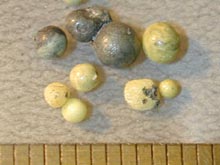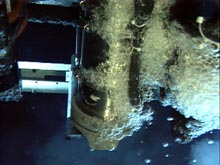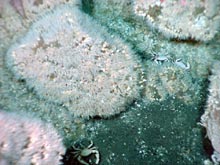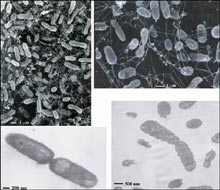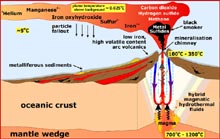
Cross-section of a typical submarine volcano with an active hydrothermal system. As magma ascends, water and gases contained in magma exsolve and enter the deep hydrothermal system as pressure is released. Click image for larger view and more details.
Role of Magmatic Fluids in Hydrothermal Vents
on Volcanic Arcs
David A. Butterfield
Joint Institute for the Study of the Atmosphere and Ocean
University of Washington
Pacific Marine Environmental Laboratory, NOAA
Background
For almost three decades, scientists have been exploring and sampling the hot spring environments of the mid-ocean ridge, where oceanic plates diverge and volcanic processes create new ocean crust. Although there are still surprises along the mid-ocean ridge, the environment along the “divergent margins” has been extensively explored and we have a reasonable understanding of the range of features and composition of hot spring fluids there. Reactions that approach equilibrium between seawater and hot basalt are the primary control on vent fluid composition on the mid-ocean ridge.
At the other end of the oceanic plate, where subduction occurs
and the plate is recycled into the earth's mantle, there is a much higher
diversity in the settings of volcanic activity, and there has been much
less study of the type of hot spring and hydrothermal features that might
exist. There are thousands of kilometers of volcanic arcs behind deep ocean
trenches along the “convergent margins” where oceanic crust is
subducted. Many of the volcanic islands and submarine volcanoes along these
arcs have active hydrothermal systems, but there has been very little direct
observation and sampling of hot springs from submersibles. As a consequence,
we know very little about the range of hot spring features and fluid compositions
on arc volcanoes.
What is predicted?
In the subduction zone of convergent oceanic margins, the sinking oceanic plate carries large quantities of water and sediment down into the mantle. Water and other volatile components in the subducting slab are expelled and cause increased mantle melting and magma production. This leads to the prediction that the magma and volcanic rocks produced along volcanic arcs will have a much higher water and volatile content. Other elements that are enriched in old ocean crust should also be enriched in the volcanic areas associated with subduction zones. This has been verified in much detail by the study of rock chemistry along volcanic arcs and back-arc spreading centers.
High volatile content in the magmas may also lead to high
levels of magmatic volatiles in the hot spring fluids. There is a great
deal of evidence from gases sampled on volcanic islands that subducted
volatiles are cycled through magma chambers and vented in fumaroles or
hot springs on land or in very shallow water near the shorelines of active
volcanic islands. Prior to 2004, there was almost no data on submarine
hot springs in deeper water, and exploration and sampling of submarine
volcanoes is still in an early stage.
Initial findings from the 2004 Mariana Arc expedition
In March/April, 2004, we explored five hydrothermally active submarine volcanoes between 13 and 22 degrees North on the Mariana volcanic arc. The first result to note is that we hit the jackpot in finding magmatic volatile influence in submarine hot springs. The second result is that the hot spring features on the arc volcanoes that we studied are quite varied and different from those on the mid-ocean ridges.
Gas-charged vents. We found two extreme cases of magmatic gas dominating the chemical composition of hot springs in the Mariana Arc submarine volcanoes. At NW Rota, magmatic sulfur dioxide is escaping from a shallow level magma chamber and mixing with seawater in different ways within the volcano. The sulfur dioxide gas reacts with water to form sulfuric acid, which can attack and dissolve the rock of the volcano. Other products of the sulfur dioxide reaction are hydrogen sulfide and elemental sulfur, which is blasted out of a crater to form spherical drops of molten sulfur that harden in the cold seawater. Molten sulfur can exist over the range of temperature from 113 to 444 degrees Celsius. The second extreme case of magmatic volatiles appeared at NW Eifuku volcano, 1600 meters below the sea surface. At this site, we found buoyant droplets of liquid carbon dioxide. This is only the second major occurrence of this kind of venting, the other case found over a decade ago in the Okinawa trough. At NW Eifuku, the carbon dioxide-rich vents are probably fueled by degassing of a carbon-rich magma. We are studying the details of the carbon isotopic composition of the samples we recovered in order to learn more about the role of subduction in the carbon dioxide-rich vents. There has been widespread interest in the NW Eifuku site as an opportunity to study the effects of liquid carbon dioxide on ocean chemistry and on the animals that live on or near the seafloor.
Low-temperature vents dominate. Another difference between
hydrothermal vents on submarine arc volcanoes of the Marianas and mid-ocean
ridge volcanoes is the dominance of low-temperature, diffuse venting on
the arc. We found only one high-temperature site where sulfide mineral
chimneys formed on the Marianas. We have not explored enough of the seafloor
in arc environments to make a general conclusion about this, but the first
look suggests that diffuse venting dominates along the arc volcanoes. The
contrast between the arc and the mid-ocean ridge is surely linked to the
contrast in geologic structure. Mid-ocean ridges are dominated by linear
volcanic ridges with a layered structure, while many arc volcanoes are
conical with chaotic and highly variable internal structure.
Volcanic Arc Microbial Habitat
Because the range of chemical composition is even more extreme along volcanic arcs than on the mid-ocean ridge, there are habitat conditions that must be outside the range that mid-ocean ridge microbes can tolerate. To take just one example, hot spring fluids on NW Rota have pH of 2.0 or less, compared to mid-ocean ridge values that are typically 3.5 to 4.5 and rarely as low as 3.0. That means that the concentration of acid is at least a factor of 10 higher at NW Rota than at mid-ocean ridge vents. We have found DNA evidence for microbes living in these extremely acidic fluids. The diversity of microbes is relatively low, and there is some similarity to known heat- and acid-tolerant microbes from other environments.
The extensive evidence gathered over several years from the hydrothermal plumes above the Kermadec Arc submarine volcanoes strongly suggests that we will encounter extreme vent fluids in the Pisces submersible dives. Working closely with New Zealand colleagues during Ocean Exploration Submarine Ring of Fire operations in these environments in April/May 2005, we expect to find new and unique microbes. This is part of an ongoing, international effort to understand the diversity of microbial life on our planet and to discover microbial capabilities and products (e.g. enzymes, antibiotics) that can benefit society and the environment.
Sign up for the Ocean Explorer E-mail Update List.



























